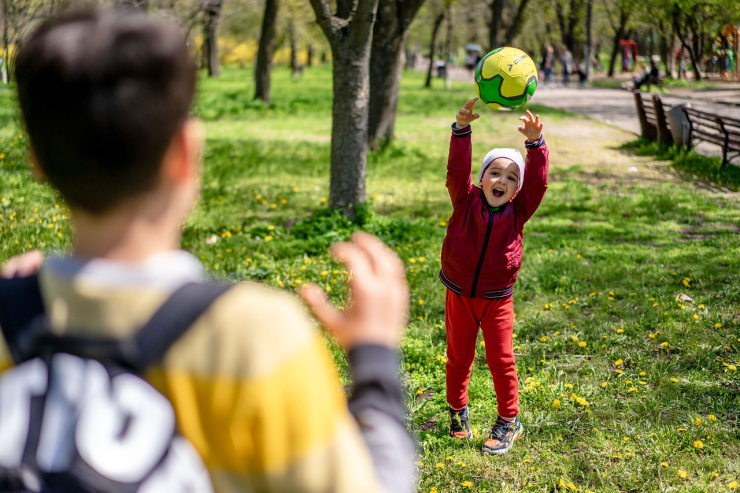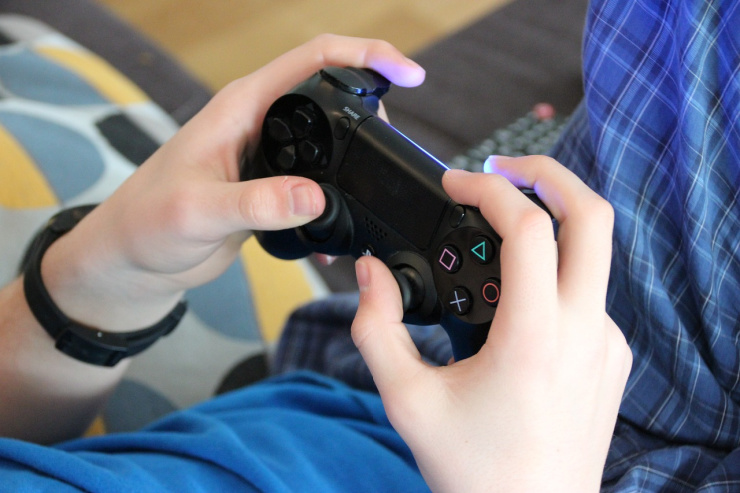Your child’s eye health can be impacted by prolonged use of digital devices like laptops, mobile phones, tablets, and video games. Knowing these impacts is key to protecting their vision. Let’s look at understanding eye health and screen time,
Impacts of Digital Screens on Children’s Vision
Digital devices can lead to digital eye strain. This happens because of prolonged focus on small screens. Your child’s eyes may feel tired, dry, or irritated after using these devices for a long time.
An 18-24 inch distance is recommended between the eyes and screens to reduce strain. The 20-20-20 rule can also help: every 20 minutes, have your child look at something 20 feet away for 20 seconds. This helps in resting their eyes and reducing strain.
Nearsightedness (myopia) is another concern. Long periods of screen time can increase the risk of children developing this condition. Encourage outdoor activities as natural light and looking at distant objects can slow myopia progression.
Regular eye exams are crucial. Visiting an eye doctor ensures any vision problems are caught early. Comprehensive eye exams can detect signs of digital eye strain, myopia, and ensure overall eye health. Implementing screen time limits and taking regular breaks can help maintain good eye health for your child.
Establishing a Healthy Gaming Environment
Creating a gaming space that protects your child’s eyesight is crucial. This involves ensuring proper lighting, using appropriate eyewear, and maintaining an ergonomic setup.
Proper Lighting and Screen Placement
Lighting is important when gaming. Make sure the room isn’t too dark or too bright. Use soft, ambient light to reduce glare on the screen.
Place the screen at eye level and about 20-30 inches away from your child’s eyes. This prevents eyestrain and amblyopia. Avoid placing the screen near windows or direct light sources to reduce reflections and glare. Adjust the screen brightness to match the room’s lighting.
Encourage breaks. Remind your child to follow the 20-20-20 rule: every 20 minutes, look at something 20 feet away for at least 20 seconds.
Choosing the Right Eyewear for Gaming
Gaming glasses can help reduce eyestrain. Look for ones with an anti-reflective coating to cut down on glare. Some glasses also have blue light filtering to ease eye fatigue from long screen times.
Consult with an optometrist to find the best glasses for your child’s needs. Prescription gaming glasses are available if your child already wears glasses.
Wearing the right eyewear can make a big difference in comfort during gaming sessions.
Creating an Ergonomic Gaming Setup
Proper posture is essential. Ensure your child sits with their back straight and their feet flat on the floor or on a footrest. The chair should support the back to prevent shoulder pain.
Adjust the desk height so your child’s arms are at a 90-degree angle when using the keyboard and mouse. The screen should be directly in front to avoid neck strain.
Encourage your child to change positions regularly and take short breaks to stand up and stretch. This helps reduce eye fatigue and keeps the body from getting stiff.
By focusing on these areas, you can help protect your child’s eyesight while they enjoy their gaming time.
Scheduling and Taking Breaks
Taking regular breaks while using screens is essential in protecting your child’s eyesight. Ensuring they follow specific guidelines can reduce eye strain and promote better eye health.
Incorporating the 20-20-20 Rule
The 20-20-20 rule is simple: Every 20 minutes, look at something 20 feet away for 20 seconds. This helps rest the eyes and reduce eye fatigue.
When kids focus on screens for long periods, they tend to blink less, leading to dry eyes. Setting a timer can help remind them to take these frequent breaks. Encourage them to look out the window or across the room.
Blinking exercises during breaks are also beneficial. Remind them to blink naturally to maintain moisture in their eyes. Combining these habits with good posture can significantly reduce eye strain.
Protecting Against Long-Term Damage
Prolonged gaming can put your child’s eyesight at risk. Routine eye care, managing myopia, and preventing blue light damage are key to ensuring your child’s eye health.
Routine Eye Care for Children
Regular visits to the optician are crucial. Opticians can spot signs of issues like myopia—a condition where distant objects appear blurry. Scheduling an eye exam with an optometrist at least once a year helps catch problems early.
During these visits, eye doctors use specialised tools to inspect the overall health of your child’s eyes. They might ask about your child’s screen time and any symptoms they might have like headache or eye strain.
Appointments should also include a dialogue about safe screen habits. The American Optometric Association recommends that children should have their first eye exam at six months old, again at three years, and every year after starting school.
Managing Myopia and Preventing Progression
Myopia, or nearsightedness, is becoming more common in kids. Spending time outdoors helps reduce the risk. Aim for at least two hours of outdoor play daily.
Additionally, taking breaks from screens helps manage eye strain. The 20-20-20 rule is effective: Every 20 minutes, look at something 20 feet away for 20 seconds.
Prescription glasses or contact lenses from an eye doctor can also help correct vision. Regular eye exams ensure prescriptions stay up-to-date.
In some cases, special contacts or atropine eye drops might be recommended to slow myopia’s progression.
Avoiding Blue Light and Computer Vision Syndrome
Digital screens emit blue light, which can lead to computer vision syndrome (CVS). Symptoms include headaches, dry eyes, and blurred vision.
Using blue light filters on screens can reduce exposure. Encourage your child to take frequent breaks from digital screens. The American Academy of Pediatrics suggests limiting screen time to no more than two hours per day for children over two years old.
Proper lighting in the room and maintaining a safe distance from the screen helps prevent eye strain. Regular blinking is also important as it keeps the eyes moist and reduces discomfort.
Finally, consider getting your child’s eyes checked if they complain of headaches or eye strain after screen use. An eye doctor can provide solutions to protect their vision.
Promoting Healthy Habits Beyond Screen Time

Children can benefit significantly from engaging in activities away from screens. Outdoor play and specific eye exercises are crucial for maintaining good vision and overall health.
Encouraging Outdoor Play and Physical Activities
Outdoor play helps kids develop better hand-eye coordination and physical strength. Encourage your kids to spend at least an hour outside each day. Games like tag, soccer, or bike riding are excellent ways to get them moving.
Being outside also lets children explore their surroundings and engage in creative play. This not only supports physical health but also promotes social skills.
Limiting screen time before bed can help improve sleep quality, contributing to better overall health. Make sure screens are turned off at least an hour before bedtime.
Educating on the Importance of Eye Exercises
Eye exercises can help reduce eye strain from too much screen time. Teach your child the 20-20-20 rule: every 20 minutes, look at something 20 feet away for 20 seconds. This helps their eyes rest and refocus.
Simple eye exercises like focusing on a distant object, then on a close one can improve eye coordination. Encourage practice of these exercises during breaks from screens.
Regular eye check-ups are essential to catch refractive errors early. If your child complains of frequent squinting or blurry vision, consider a visit to an eye specialist. Vision therapy may also be an option for continued eye health.
When to Consult Eye Care Professionals
It’s important to know when to consult an eye care professional for your child’s gaming habits. Watch for certain signs that may indicate a need for professional help.
Signs to Look For:Eye Fatigue and Strain:
If your child complains about tired or heavy eyes, it might be a sign that they need an eye check-up.
- Blurry Vision: Difficulty seeing clearly, even for short periods, can be a warning sign.
- Irritated Eyes: Red, itchy, or watery eyes can mean it’s time for a visit to the eye doctor.
- Light Sensitivity: If your child is squinting or complaining about bright lights, this could be an issue.
- Focusing Issues: Trouble keeping focus during or after gaming can indicate a problem.
Regular eye exams are crucial for catching vision problems early. It’s recommended by organizations like the American Academy of Pediatrics, the American Academy of Ophthalmology, and the American Optometric Association. These exams can help detect any issues with eye coordination and overall eye health.
Eye Exams and Appointments:
- Schedule a comprehensive eye exam if your child shows any of the signs mentioned. This is especially important if they wear glasses or contact lenses.
- An eye doctor can provide guidance tailored to your child’s specific needs, including recommendations on gaming habits that protect eye health.
Making an appointment with an eye care professional can ensure your child’s vision is protected while they enjoy their favourite games.

